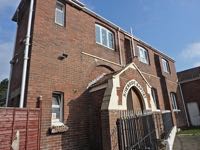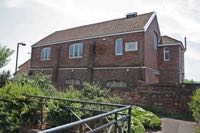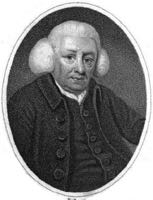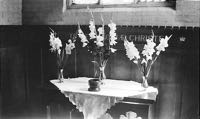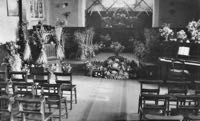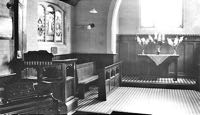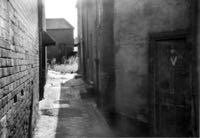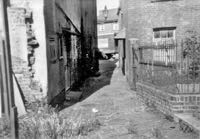
The Tabernacle Chapel Under the Old City Wall
'Ye Tabernacle Under Ye Old City Walls'
Researched and written by Stephen Bees
Page added 9th November 2014
 Henry Tanner was an Exeter man, born at St. Sidwells in 1718. Leaving Exeter, Henry travelled to Plymouth and worked as a carpenter and foreman in ship building. At Plymouth he became influenced by the preaching of Rev. George Whitfield. Returning to Exeter, as a widower with three children, Henry linked up with a group of Methodists in Rock Lane and became its leader. There is no evidence he was ordained.
Henry Tanner was an Exeter man, born at St. Sidwells in 1718. Leaving Exeter, Henry travelled to Plymouth and worked as a carpenter and foreman in ship building. At Plymouth he became influenced by the preaching of Rev. George Whitfield. Returning to Exeter, as a widower with three children, Henry linked up with a group of Methodists in Rock Lane and became its leader. There is no evidence he was ordained.
The Tabernacle Chapel was built by the Rev. Tanner in 1769, the first to be constructed after George’s Meeting House opened nine years before. As a Calvinistic Methodist churches, it was known as a Tabernacle. The Tabernacle was built with little or no funds, or as he described , ‘with Faith and Prayer,' at the bottom of Coombe Street (Rock Lane, near Quay Hill) in the impoverished West Quarter. Over a hundred years later the Tabernacle was described as: “two or three old houses knocked into one, a quaint little porch, and a modest bit of green turf in front, surrounded by straight thin iron railings."
The Rev. Tanner always rose very early in the morning, around 4:30. He would preach three times on Sundays and twice during the week. In addition he also preached at Crediton, Moreton Hampstead, Topsham and other places – travelling on horseback, in all weather conditions. Aside from his preaching, Henry continued to labour as a millwright and carpenter, working to repair the mills around the river Exe and in Exeter town.
An indication of the times can be imagined when the Rev. Tanner, known as Pastor Tanner, and his family would sometimes have a constable escort them from the Tabernacle to his house, because of threats and insults from the disturbed congregation. Magistrates were known to say when dealing with persistent offenders… should we send him down to Old Tanner’s.
With the advent of the Register for Baptism 1775–1818, the first entry of a baptism at Coombe Street Tabernacle was recorded 1776. The next year, 1777, a very rare recorded baptism of two adults was conducted by the Rev. Tanner: “by immersion in the River Exe, in the morning about 6 o’clock.“ (near Rev. Tanner's house.)
The Reverend's last service
After 35 years as minister of the Tabernacle, the Rev. Tanner, aged 86, was carried in a chair to the pulpit for his last service – and taken from the pulpit unable to finish his sermon. He died later that evening. He was interred in a cave at St. Bartholomew's Yard. The Rev. Tanner did much good work, however a book review of his Life and Writings was unflattering. His second wife, Mary, died two years later and in her will made a provision to support the new minister, provided he believed in the the baptist Confession of Faith, 1689, London.
The Tabernacle, was also recorded as a Methodist Meeting / Independent Chapel, is marked on Tozer's 1793 map, Britton's 1805, Beasley's 1835 map, OS 1891 and others. The actual name Tabernacle Court appears in newspaper adverts from 1816 and 1821, and the Exeter Itinerary & General Directory of 1828 refers to: Tabernacle Court in which is the Tabernacle or Tanner's Meeting.
By the 1850s worship by members of the Tabernacle declined and the last service was circa 1887 – further up Coombe Street, The Primitive Methodist, formerly Victoria Chapel, had been sold several years earlier.
In the 1890s the Tabernacle was described as: ‘now requires restoration, fell into decay and old disused chapel.’ Eventually, the remains of the building were cleared away by the City Council and the site assigned by the Charity Trustees to the Trustees of Friernhay Congregational Church.
But that was not the end of the story. The Charity Commission in 1900 sought permission for a scheme to sell the site, but with a need of a church in closer walking distance in the West Quarter, it was decided to build a new church on the site of the old Tabernacle. It was to be large enough to seat 150. With an estimated cost of about £250, work would begin when near this amount.
The Western Times in 1902 proudly announced: “An Historical Place Re-built and Re-opened, and, Ye Tabernacle Under Ye Old City Walls. The place is to be known as St John's Congregational Church.“ (The church would also be known as St John's, Coombe Street). A compact little one-manual organ was obtained, that formerly stood at St. Chad’s, Haggerston, London.
The Mayor of Exeter and a future MP, Albert Dunn, who took an active interest in Friernhay Congregational Church, is mentioned as the founder of St. John’s and one of its trustees.
For social work functions St. John’s had used the temperance club at the Cricklepit Arms. This was no longer possible, and in 1905 St. John’s was enlarged.
Adjoining the church was a shabby tenement house(s) that was acquired and transformed into a large hall with a small room at the back. The hall could accommodate over 100 and was to be used mostly for social functions. It was opened by Mayor Perry and the ex mayor, Albert Dunn, the honorary town clerk.
The wall collapses
Tabernacle Court was one of the oldest courts of the city slums. In 1927 part of the old city wall near the Tabernacle Court collapsed, destroying the Custom House Inn. It was around this time the Council made plans for the redevelopment of the West Quarter and many residents would be rehoused in the new suburbs, of Burnthouse Lane. Although Tabernacle Court continued to have residents, one of the last comments for St John’s was in a newspaper of 1945 which referred to the former Sunday School of St. John’s in Coombe Street.
What happened to St. John’s over the next 50 odd years? Today the Riverside Baptist Church continues the tradition of a place of worship in Tabernacle Court.
Sources: Exeter Flying Post, Western Times, Exeter and Plymouth Gazette, Nonconformist Registers, Nonconformity in Exeter 1650-1875, Annual Review of History of Literature.Volume 6, Memoir of the Life and Writings of the Late Rev Henry Tanner by Rev R Hawker. 2nd edition, Ancestry.co.uk, britainfromabove.org.uk, various maps and directories.
│ Top of Page │
